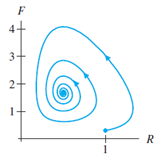
Consider the predator-prey system
The figure to the right shows a computer generated plot of a solution curve for this system in the RF-plane. (a) Describe the fate of the prey (R)and predator (F)populations based on this image.
(b) Confirm your answer using HPGSystemSolver.

Want to see the full answer?
Check out a sample textbook solution
Chapter 2 Solutions
Differential Equations
- In a company with 80 employees, 60 earn $10.00 per hour and 20 earn $13.00 per hour. a) Determine the average hourly wage. b) In part a), is the same answer obtained if the 60 employees have an average wage of $10.00 per hour? Prove your answer.arrow_forward1. Estimate the area under the graph of f(x)-25-x from x=0 to x=5 using 5 approximating rectangles Using: (A) right endpoints. (B) left endpoints.arrow_forwardThe following ordered data list shows the data speeds for cell phones used by a telephone company at an airport: A. Calculate the Measures of Central Tendency from the ungrouped data list. B. Group the data in an appropriate frequency table. 0.8 1.4 1.8 1.9 3.2 3.6 4.5 4.5 4.6 6.2 6.5 7.7 7.9 9.9 10.2 10.3 10.9 11.1 11.1 11.6 11.8 12.0 13.1 13.5 13.7 14.1 14.2 14.7 15.0 15.1 15.5 15.8 16.0 17.5 18.2 20.2 21.1 21.5 22.2 22.4 23.1 24.5 25.7 28.5 34.6 38.5 43.0 55.6 71.3 77.8arrow_forward
- 9. Use fundamental theorem of calculus to find the derivative d a) *dt sin(x) b)(x)√1-2 dtarrow_forward3. Evaluate the definite integral: a) √66x²+8dx b) x dx c) f*(2e* - 2)dx d) √√9-x² e) (2-5x)dx f) cos(x)dx 8)²₁₂√4-x2 h) f7dx i) f² 6xdx j) ²₂(4x+3)dxarrow_forward2. Consider the integral √(2x+1)dx (a) Find the Riemann sum for this integral using right endpoints and n-4. (b) Find the Riemann sum for this same integral, using left endpoints and n=4arrow_forward
- 5. For the function y-x³-3x²-1, use derivatives to: (a) determine the intervals of increase and decrease. (b) determine the local (relative) maxima and minima. (e) determine the intervals of concavity. (d) determine the points of inflection. (e) sketch the graph with the above information indicated on the graph.arrow_forwardName: Tan Tong 16.5 Bonvicino - Period 5 1 Find the exact volume of a right hexagonal prism such that the base is a regular hexagon with a side length of 8 cm and whose distance between the two bases is 5 cm. Show all work. (4 pts) 83 tan 30°= Regular hexagon So length ~ 480 tango Cm Hexagon int angle =36016 8cm Angle bisec isper p bisect Side length 4 X=an 300 2 In the accompanying diagram of circle O, PA is tangent to the circle at A, PDC is a secant, diameter AEOC intersects chord BD at E, chords AB, BC, and DA are drawn, mDA = 46° and mBC is 32° more than mAB. If the radius of the circle is 8 cm, E is the midpoint of AO and the length of ED is 2 less than the length of BE, answer each of the following. Show all work. (a) marrow_forward18:36 G.C.A.2.ChordsSecantsandTa... จ 76 完成 2 In the accompanying diagram, AABC is inscribed in circle O, AP bisects BAC, PBD is tangent to circle O at B, and mZACB:m/CAB:m/ABC= 4:3:2 D B P F Find: mZABC, mBF, m/BEP, m/P, m/PBC ← 1 Őarrow_forward14:09 2/16 jmap.org 5G 66 In the accompanying diagram of circle O, diameters BD and AE, secants PAB and PDC, and chords BC and AD are drawn; mAD = 40; and mDC = 80. B E Find: mAB, m/BCD, m/BOE, m/P, m/PAD ← G.C.A.2.ChordsSecantsand Tangent s19.pdf (538 KB) + 4 保存... Xarrow_forward16:39 < 文字 15:28 |美图秀秀 保存 59% 5G 46 照片 完成 Bonvicino - Period Name: 6. A right regular hexagonal pyramid with the top removed (as shown in Diagram 1) in such a manner that the top base is parallel to the base of the pyramid resulting in what is shown in Diagram 2. A wedge (from the center) is then removed from this solid as shown in Diagram 3. 30 Diogram 1 Diegrom 2. Diagram 3. If the height of the solid in Diagrams 2 and 3 is the height of the original pyramid, the radius of the base of the pyramid is 10 cm and each lateral edge of the solid in Diagram 3 is 12 cm, find the exact volume of the solid in Diagram 3, measured in cubic meters. Show all work. (T 文字 贴纸 消除笔 涂鸦笔 边框 马赛克 去美容arrow_forwardAnswer question 4 pleasearrow_forwardarrow_back_iosSEE MORE QUESTIONSarrow_forward_ios
- Algebra & Trigonometry with Analytic GeometryAlgebraISBN:9781133382119Author:SwokowskiPublisher:Cengage
 Elementary Linear Algebra (MindTap Course List)AlgebraISBN:9781305658004Author:Ron LarsonPublisher:Cengage Learning
Elementary Linear Algebra (MindTap Course List)AlgebraISBN:9781305658004Author:Ron LarsonPublisher:Cengage Learning Algebra and Trigonometry (MindTap Course List)AlgebraISBN:9781305071742Author:James Stewart, Lothar Redlin, Saleem WatsonPublisher:Cengage Learning
Algebra and Trigonometry (MindTap Course List)AlgebraISBN:9781305071742Author:James Stewart, Lothar Redlin, Saleem WatsonPublisher:Cengage Learning  College AlgebraAlgebraISBN:9781305115545Author:James Stewart, Lothar Redlin, Saleem WatsonPublisher:Cengage Learning
College AlgebraAlgebraISBN:9781305115545Author:James Stewart, Lothar Redlin, Saleem WatsonPublisher:Cengage Learning Linear Algebra: A Modern IntroductionAlgebraISBN:9781285463247Author:David PoolePublisher:Cengage Learning
Linear Algebra: A Modern IntroductionAlgebraISBN:9781285463247Author:David PoolePublisher:Cengage Learning




